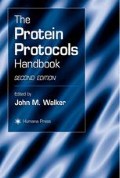Abstract
Understanding the function of proteins requires determination of their structures. Advances in chemical technology make it possible to obtain a picture of global protein expression in model organisms such as the yeast Saccharomyces cerevisiae. Instrumental to these breakthroughs was the development of high-resolution two-dimensional gel electrophoresis and mass spectrometric means for rapid detection and analysis of peptides and proteins. While sequence information on single spots separated by two-dimensional electrophoresis can be quickly obtained by today’s technology, structural characterization of proteins expressed in low abundance is still a difficult task. For example, in our attempts to isolate components of the import machinery of yeast mitochondria, some proteins turned out to be expressed at extremely low levels, and it soon became evident that conventional purification techniques were impractical to obtain these proteins in amounts sufficient for structural analysis. Furthermore, some proteins of the mitochondrial import machinery were rapidly degraded by proteases, and they could be obtained intact only by first denaturing mitochondria with trichloroacetic acid and then solubilizing them in boiling sample buffer for sodium dodecyl sulfate-polyacrylamide gel electrophoresis (SDS-PAGE) (1). This in turn made the separation of several milligrams of denatured proteins necessary, which was best achieved by preparative SDS-PAGE followed by electroelution of individual proteins.
References
Horst, M., Jenö, P., Kronidou, N. G., Bolliger, L., Oppliger, W., Scherer, P., et al. (1993) Protein import into yeast mitochondria: the inner membrane import site ISP45 is the MPI1 gene product. EMBO J. 12, 3035–3041.
Wessel, D. and Flügge, U. I. (1984) A method for the quantitative recovery of protein in dilute solution in the presence of detergent and lipids. Analyt. Biochem. 138, 141–143.
Stearne, P. A., van Driel, I. R., Grego, B., Simpson, R. J., and Goding, J. W. (1985) The murine plasma cell antigen PC-1: purification and partial amino acid sequence. J. Immunol. 134, 443–448.
Konigsberg, W. H. and Henderson, L. (1983) Removal of sodium dodecylsulfate from proteins by ion-pair extraction. Meth. Enzymol. 91, 254–259.
Bosserhoff, A., Wallach, J., and Frank, R. (1989) J. Chromatogr. 437, 71–77.
Simpson, R. J., Moritz, R. L., Nice, E. E., and Grego, B. (1987) A high-performance liquid chromatography procedure for recovering subnanomole amounts of protein from SDS-gel electroeluates for gas-phase sequence analysis. Eur. J. Biochem. 165, 292–298.
Jenö, P., Scherer, P., Manning-Krieg, U., and Horst, M. (1993) Desalting electroeluted proteins with hydrophilic chromatography. Analyt. Biochem. 215, 292–298.
Alpert, A. J. (1990) Hydrophilic-interaction chromatography for the separation of pep-tides, nucleic acids and other polar compounds. J. Chromatogr. 215, 292–298.
Laemmli, M. K. (1974) Cleavage of structural proteins during the assembly of the head of bacteriophage T4. Nature. 227, 680–685.
Hager, D. A. and Burgess, R. (1980) Elution of proteins from sodium dodecyl sulfate poly-acrylamide gels, removal of sodium dodecyl sulfate, and renaturation of enzymatic activity: results with sigma subunit of Escherichia coli RNA polymerase, wheat germ DNA topoisomerase, and other enzymes. Analyt. Biochem. 109, 76–86.
Higgins, R. C. and Dahmus, M. E. (1979) Rapid visualization of protein bands in preparative SDS-polyacrylamide gels. Analyt. Biochem. 93, 257–260.
Jacobs, E. and Clad, A. (1986) Electroelution of fixed and stained membrane proteins from preparative sodium dodecyl sulfate polyacrylamide gels into a membrane trap. Analyt. Biochem. 154, 583–589.
Author information
Authors and Affiliations
Editor information
Editors and Affiliations
Rights and permissions
Copyright information
© 2002 Humana Press Inc., Totowa, NJ
About this protocol
Cite this protocol
Jenö, P., Horst, M. (2002). Electroelution of Proteins from Polyacrylamide Gels. In: Walker, J.M. (eds) The Protein Protocols Handbook. Springer Protocols Handbooks. Humana Press. https://doi.org/10.1385/1-59259-169-8:299
Download citation
DOI: https://doi.org/10.1385/1-59259-169-8:299
Publisher Name: Humana Press
Print ISBN: 978-0-89603-940-7
Online ISBN: 978-1-59259-169-5
eBook Packages: Springer Book Archive

